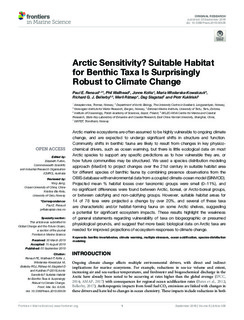| dc.contributor.author | Renaud, Paul Eric | |
| dc.contributor.author | Wallhead, Philip | |
| dc.contributor.author | Kotta, Jonne | |
| dc.contributor.author | Wlodarska-Kowalczuk, Maria | |
| dc.contributor.author | Bellerby, Richard | |
| dc.contributor.author | Ratsep, Merli | |
| dc.contributor.author | Slagstad, Dag | |
| dc.contributor.author | Kuklinski, Piotr | |
| dc.date.accessioned | 2019-11-20T13:29:35Z | |
| dc.date.available | 2019-11-20T13:29:35Z | |
| dc.date.created | 2019-10-24T16:21:22Z | |
| dc.date.issued | 2019 | |
| dc.identifier.citation | Frontiers in Marine Science. 2019, 6, Article 538. | nb_NO |
| dc.identifier.issn | 2296-7745 | |
| dc.identifier.uri | http://hdl.handle.net/11250/2629536 | |
| dc.description.abstract | Arctic marine ecosystems are often assumed to be highly vulnerable to ongoing climate change, and are expected to undergo significant shifts in structure and function. Community shifts in benthic fauna are likely to result from changes in key physico-chemical drivers, such as ocean warming, but there is little ecological data on most Arctic species to support any specific predictions as to how vulnerable they are, or how future communities may be structured. We used a species distribution modeling approach (MaxEnt) to project changes over the 21st century in suitable habitat area for different species of benthic fauna by combining presence observations from the OBIS database with environmental data from a coupled climate-ocean model (SINMOD). Projected mean % habitat losses over taxonomic groups were small (0–11%), and no significant differences were found between Arctic, boreal, or Arcto-boreal groups, or between calcifying and non-calcifying groups. However, suitable habitat areas for 14 of 78 taxa were projected a change by over 20%, and several of these taxa are characteristic and/or habitat-forming fauna on some Arctic shelves, suggesting a potential for significant ecosystem impacts. These results highlight the weakness of general statements regarding vulnerability of taxa on biogeographic or presumed physiological grounds, and suggest that more basic biological data on Arctic taxa are needed for improved projections of ecosystem responses to climate change. | nb_NO |
| dc.language.iso | eng | nb_NO |
| dc.publisher | Frontiers Media | nb_NO |
| dc.rights | Navngivelse 4.0 Internasjonal | * |
| dc.rights.uri | http://creativecommons.org/licenses/by/4.0/deed.no | * |
| dc.title | Arctic Sensitivity? Suitable Habitat for Benthic Taxa Is Surprisingly Robust to Climate Change | nb_NO |
| dc.type | Journal article | nb_NO |
| dc.type | Peer reviewed | nb_NO |
| dc.description.version | publishedVersion | nb_NO |
| dc.source.pagenumber | 1-14 | nb_NO |
| dc.source.volume | 6 | nb_NO |
| dc.source.journal | Frontiers in Marine Science | nb_NO |
| dc.identifier.doi | 10.3389/fmars.2019.00538 | |
| dc.identifier.cristin | 1740348 | |
| cristin.unitcode | 7464,20,14,0 | |
| cristin.unitname | Marin biogeokjemi og oseanografi | |
| cristin.ispublished | true | |
| cristin.fulltext | original | |
| cristin.qualitycode | 1 | |

